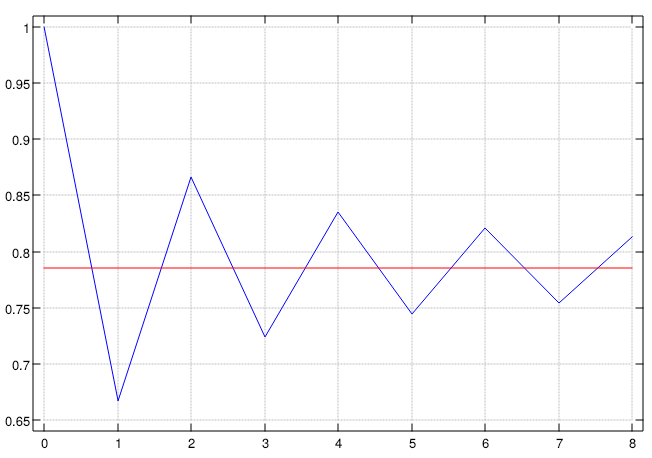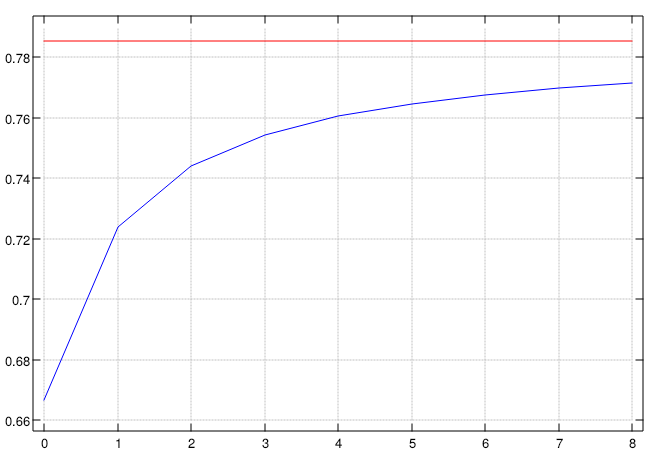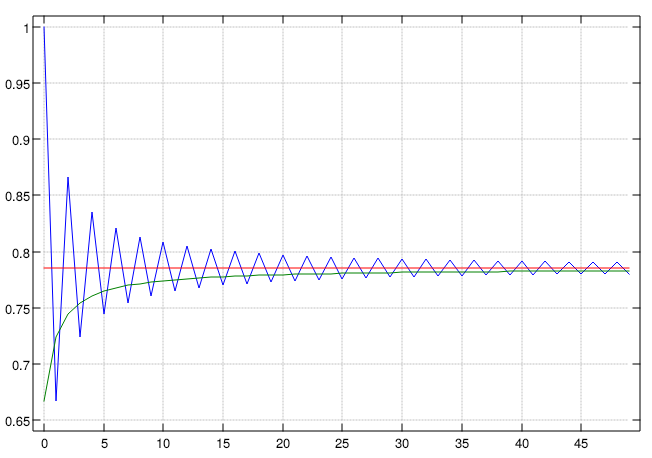
I got to reading about different methods of calculating Pi and couldn't resist implementing at least one in J.
1 - 1/3 + 1/5 - 1/7 + 1/9 ... = π/4
An alternating series is an infinite series in which the terms flip-flop in sign (from positive to negative to positive etc.). On reading that I immediately started thinking of how you might programmatically define the calculation of an alternating series (the most naive way being something like cycling between the two operations). It was only in reading further than I realized you can encode the same logic with plain old math. This is accomplished by raising -1 to the power of each element in the series:
i.9
0 1 2 3 4 5 6 7 8
_1^i.9
1 _1 1 _1 1 _1 1 _1 1The denominators for the series are not integers, but instead odd numbers. This can be accomplished with 1+2×n (or, the successor of double some n):
>: 1 2 3
2 3 4
+: 1 2 3
2 4 6
>:&+: 1 2 3
3 5 7What remains then is taking the quotient of these two series and summing them, which could look like this:
]series =: (_1^ i.9) % (>:&+: i.9)
1 _0.333333 0.2 _0.142857 0.111111 _0.0909091 0.0769231 _0.0666667 0.0588235
+/ series
0.813091But that is just a long-winded form of the same tacit expression:
+/ @ (_1&^ % >:&+:)
The first nine terms can be seen here, the red line is the value of
π/4 and the blue line is progression of our Pi calculation:

While the above form might be written in crude ASCII-math
like: π/4 = 𝚺 (-1)ⁿ/(2n+1) there exists another form
without the alternating series that can (apparently) evaluate high
precision in a small number of terms: π/4 = 𝚺
2/(4n+1)(4n+3)
I was excited to see this because it finally gives me a chance to
try out a neat feature built into J — p.,
called polynomial. It
accepts the coefficients of an arbitrary polynomial expression along
with an input and returns the result (which is a wild
feature for most languages to include). All this requires is a
little simplification of the two polynomials above using some
algebra.
(4n+1)(4n+3) is equivalent to 16n²+12n+4n+3, or 16n²+16n+3, which
means the argument to the verb p. is the array 3
16 16 (the powers of the argument in coefficient form are in
ascending order). The result is a polynomial evaluator:
3 16 16 p. 1
35
3 16 16 p. 4
323
3 16 16 p. 10
1763
Combining this with a constant numerator and a final summation, the resulting verb is another tacit form, very similar to the last:
(2 % 3 16 16 & p.) i.9
0.666667 0.0571429 0.020202 0.0102564 0.00619195 0.00414079 0.00296296 0.00222469 0.0017316
+/ @ (2 % 3 16 16 & p.)

Finally, a comparison out to 50 terms of both methods:

There isn't one! I thought it was an interesting bit of math that lent itself nicely to exploring things in J. This is the first instance I can remember that constructed Pi without the use of other geometric principles (and without mentioning a circle!). I feel like I should dig into this kind of thing because it helps remove some of the "because that's how it is done" that most of my math education took.